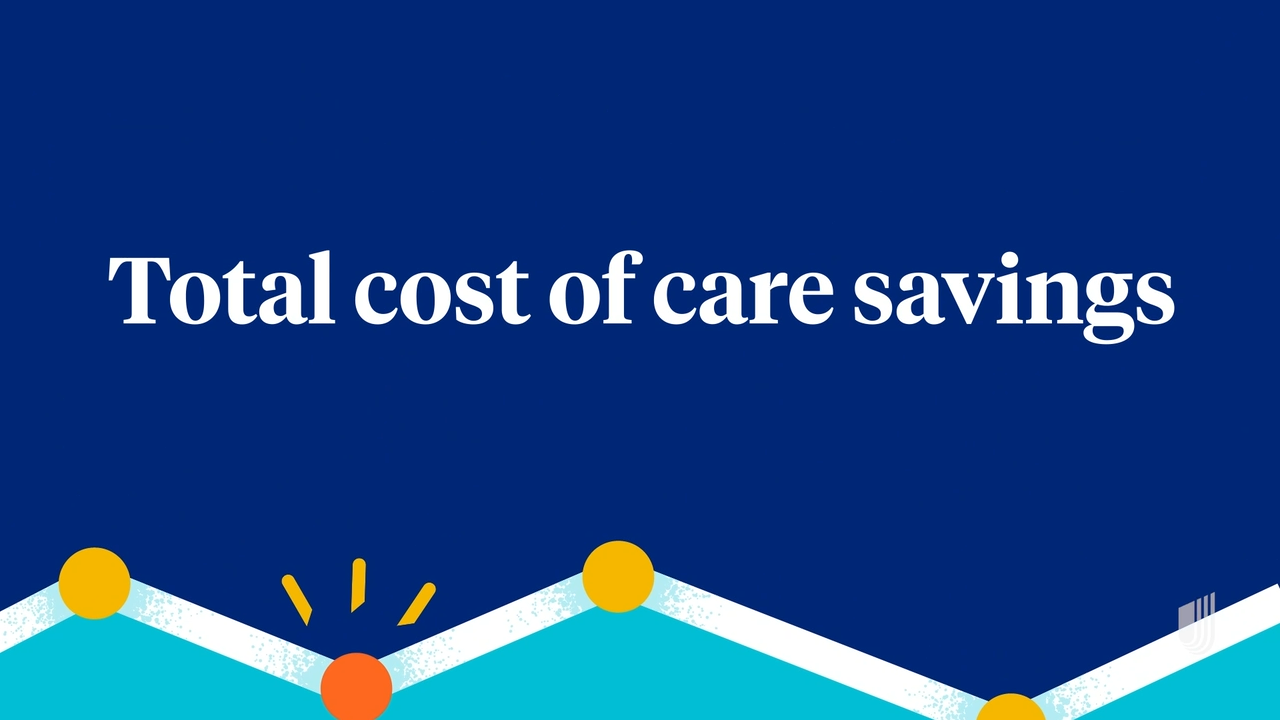Instrumental music plays throughout. A montage shows various shots of Joe Clark interviewing in an office space.
White text over a blue box enters from bottom left of screen.
ONSCREEN TEXT: Joe Clark
SVP, Broker & Consultant Strategy
UnitedHealthcare Employer & Individual
JOE: The first question out of every consultant and every employer's mouth is, prove your total cost of care to me. I hear what you're saying, but we need proof.
Music continues. Blue text appears over a white background.
ONSCREEN TEXT: Getting real about
total cost of care
Blue text dissolves revealing three blue stripes that travel across the screen. Then dissolves to Joe interviewing.
JOE: What we've done at UnitedHealthcare is gone to third-party firms to validate our savings and validate our incremental savings over our competitors.
Blue text appears over white background. Small black text appears underneath. Joe continues interviewing.
ONSCREEN TEXT: ~ 10% average lower
Total cost of care
Than other carriers*
ONSCREEN TEXT: *Wakely Consulting Group: By looking at risk-adjusted allowed claims per
member per month (PMPM) using 2021 claims data, Wakely was able to
perform a holistic comparison of UnitedHealthcare's ability to drive cost
savings for members and determined it outperformed the market by
approximately 10% - even though UnitedHealthcare is not the leader in
discounts in many of these markets. Site of care redirection, inpatient
management and preventive care utilization are key savings drivers.
Video shows an animate computer desk with a hand operating a mouse. Joe continues speaking.
JOE: So we are looking to provide the tools and the data points and the proof points to consultants and brokers that we do drive total cost of care savings.
White text appears over blue screen. Screen then reveals Joe interviewing.
ONSCREEN TEXT: Total cost of care savings
JOE: When employers look at total cost of care and they're just focused on a discount per unit cost calculation, they're only really seeing 50% of the difference between UnitedHealthcare and its competitors.
Screen reveals a blue circle that turns into a pie chart. Blue text appears in upper left corner. Joe continues speaking.
ONSCREEN TEXT: Unit costs
Circle graphs moves to left of screen revealing new blue text with an orange checkmark before each line of text. Joe continues speaking.
ONSCREEN TEXT: Clinical programs
Payment integrity
Site of care redirection
Utilization management
JOE: What a traditional discount calculation misses out on is clinical programs, payment integrity, site of care redirection, utilization management, the whole suite of other programs
that UnitedHealthcare and others offer that add up to more than 50% of the total cost of care pie.
Blue text appears over a white background. Music continues to play.
ONSCREEN TEXT: A more complete
financial picture builds
trust with employers
JOE: So if I think about self-funded employers, they need the confidence that if they're choosing UnitedHealthcare to be their carrier, that UnitedHealthcare will be a great steward of their dollars and will drive total cost savings more than anywhere else they could choose. One of the strategies we've been incorporating lately into our self-funded business is offering total cost of care…
White text appears over blue banner on upper right side of screen. Joe continues speaking.
ONSCREEN TEXT: Total cost of care
guarantees on
top of our typical
financial offer
JOE: …guarantees on top of our typical financial offer and really what that looks like is we will commit to an employer and to a consultant that we will achieve a certain amount of trend
and a certain amount of total cost. And we will put our money behind it.
White text appears over a blue background. Joe continues speaking.
ONSCREEN TEXT: Third-party validation + guarantees
ONSCREEN TEXT: Employers
Consultants & Brokers
JOE: Third-party validation and guarantees, when they're paired together, can really give the confidence to employers and to consultants of the story that we are telling, which is we manage total cost beyond discounts.
White text appears over a blue background. Joe continues interviewing.
ONSCREEN TEXT: Total cost
beyond
discounts
ONSCREEN TEXT: Total cost
of care
savings
JOE: And we drive total cost of care savings. I am incredibly proud of the work UnitedHealthcare
does to drive total cost of care savings and protect the dollars of members and employers.
Blue text appears one word at a time over a white background.
ONSCREEN TEXT: Cost
management
that
meets
the
moment
Music ends.
ONSCREEN TEXT: Talk to your broker, consultant or
UnitedHealthcare representative
to learn more
Three blue lines curl across a blue background. Blue text centers a white screen.
ONSCREEN TEXT: United
Healthcare
There for what matters TM
Small black text runs along the bottom of the screen.
ONSCREEN TEXT: Wakely Consulting Group: By looking at risk-adjusted allowed claims per
member per month (PMPM) using 2021 claims data, Wakely was able to
perform a holistic comparison of UnitedHealthcare's ability to drive cost
savings for members and determined it outperformed the market by
approximately 10% - even though UnitedHealthcare is not the leader in
discounts in many of these markets. Site of care redirection, inpatient
management and preventive care utilization are key savings drivers.
Insurance coverage provided by or through UnitedHealthcare Insurance
Company or its affiliates. Administrative services provided by
UnitedHealthcare Services, Inc. or their affiliates.
© 2023 United HealthCare Services, Inc. All rights reserved. 23-2740752
B2B EI22209550.1 12/23

